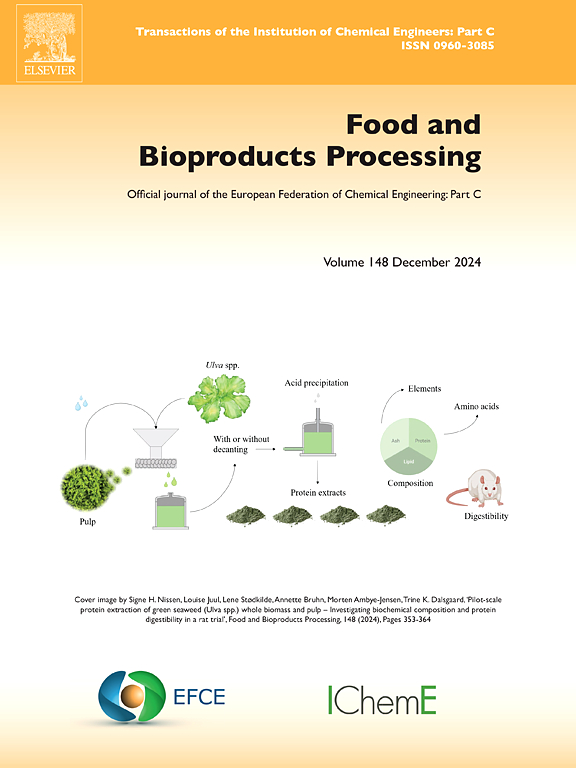Encapsulation of piperine in metal organic frameworks and evaluation of its stability, characteristics, in-vitro digestion and product fortification
IF 3.4
2区 农林科学
Q2 BIOTECHNOLOGY & APPLIED MICROBIOLOGY
引用次数: 0
Abstract
Piperine is a phytochemical known for its health beneficial properties. However, it suffers from poor solubility and stability in the aqueous system. This could be the major hurdle for the application of piperine in functional foods. These drawbacks were addressed with the encapsulation using metal organic frameworks. Therefore, his study investigates the synthesis and application of β-cyclodextrin based metal-organic frameworks (β-CD-MOFs) as a carrier for piperine encapsulation in order to enhance its solubility and stability. The β-CD-MOF and piperine were combined in different ratios (1:1, 1:2, 1:3, 1:4, 2:1, 3:1 and 4:1) for the encapsulation and optimal ratio was selected based on loading efficiency. The β-CD-MOF-to-piperine ratio of 1:2 was identified as optimal, achieved a highest loading rate of 15.36 %. SEM analysis observed a slight increase in the size of β-CD-MOF from 429.63 ± 13 nm to 463.80 ± 48 nm after encapsulation of piperine. FTIR analysis confirmed the encapsulation and retention of basic structure of MOF. XRD analysis demonstrated the retention of MOF's crystalline structure following the encapsulation of piperine. Storage study showed that the encapsulated piperine maintained absolute antioxidant activity over three months of storage at 30°C. The encapsulated piperine maintained maximum stability at various pH, processing temperature and ionic conditions. During in-vitro digestion, the antioxidant activity of encapsulated piperine was decreased from 92.92 ± 0.37 % at oral phase to 86.66 ± 0.57 % at gastric phase and 85.33 ± 0.76 % at intestinal phase. Encapsulated piperine was incorporated in flavored milk at the concentration of 10, 12.5, and 15 mg/ml and achieved an antioxidant activity of 87.11 ± 0.32 91.86 ± 0.68 and 94.45 ± 0.78 %, respectively. Sensory evaluation revealed that even lower piperine concentration (10 mg/ml) showed remarkable spiciness and pungency. Overall, this study offers valuable insights into the stabilization and delivery of piperine through β-CD-MOFs, paving the way for their application in functional foods and nutraceuticals.
胡椒碱在金属有机骨架中的包封及其稳定性、特性、体外消化和产品强化的评价
胡椒碱是一种植物化学物质,以其有益健康的特性而闻名。然而,它在水体系中的溶解度和稳定性较差。这可能是胡椒碱在功能性食品中应用的主要障碍。使用金属有机框架封装解决了这些缺点。因此,他研究了以β-环糊精为基础的金属有机骨架(β-CD-MOFs)作为胡椒碱包封载体的合成和应用,以提高其溶解度和稳定性。将β-CD-MOF与胡椒碱按不同比例(1:1、1:2、1:3、1:4、2:1、3:1和4:1)进行包封,并根据装药效率选择最佳配比。结果表明,β- cd - mof与胡椒碱的比例为1:2时最佳,最高负载率为15.36 %。扫描电镜分析发现,包封胡椒碱后,β-CD-MOF的尺寸从429.63 ± 13 nm略微增加到463.80 ± 48 nm。FTIR分析证实了MOF的包封和基本结构的保留。XRD分析表明,胡椒碱包封后MOF的晶体结构保持不变。贮藏研究表明,包封后的胡椒碱在30℃的贮藏条件下可保持3个月以上的绝对抗氧化活性。包封后的胡椒碱在各种pH值、加工温度和离子条件下均保持最大的稳定性。在体外消化,封装胡椒碱的抗氧化活性下降从92.92 ±0.37 % 86.66口语阶段 ±0.57 % 85.33胃阶段和 ±0.76 %肠道阶段。将10、12.5和15 mg/ml的胡椒碱包封在风味奶中,其抗氧化活性分别为87.11 ± 0.32 91.86 ± 0.68和94.45 ± 0.78 %。感官评价显示,即使较低的胡椒碱浓度(10 mg/ml)也表现出显著的辛辣和辛辣。总的来说,本研究为通过β- cd - mof稳定和传递胡椒碱提供了有价值的见解,为其在功能食品和营养保健品中的应用铺平了道路。
本文章由计算机程序翻译,如有差异,请以英文原文为准。
求助全文
约1分钟内获得全文
求助全文
来源期刊

Food and Bioproducts Processing
工程技术-工程:化工
CiteScore
9.70
自引率
4.30%
发文量
115
审稿时长
24 days
期刊介绍:
Official Journal of the European Federation of Chemical Engineering:
Part C
FBP aims to be the principal international journal for publication of high quality, original papers in the branches of engineering and science dedicated to the safe processing of biological products. It is the only journal to exploit the synergy between biotechnology, bioprocessing and food engineering.
Papers showing how research results can be used in engineering design, and accounts of experimental or theoretical research work bringing new perspectives to established principles, highlighting unsolved problems or indicating directions for future research, are particularly welcome. Contributions that deal with new developments in equipment or processes and that can be given quantitative expression are encouraged. The journal is especially interested in papers that extend the boundaries of food and bioproducts processing.
The journal has a strong emphasis on the interface between engineering and food or bioproducts. Papers that are not likely to be published are those:
• Primarily concerned with food formulation
• That use experimental design techniques to obtain response surfaces but gain little insight from them
• That are empirical and ignore established mechanistic models, e.g., empirical drying curves
• That are primarily concerned about sensory evaluation and colour
• Concern the extraction, encapsulation and/or antioxidant activity of a specific biological material without providing insight that could be applied to a similar but different material,
• Containing only chemical analyses of biological materials.
 求助内容:
求助内容: 应助结果提醒方式:
应助结果提醒方式:


